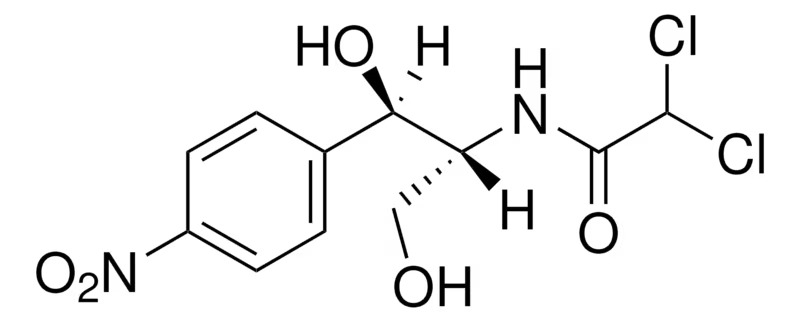Specifications:
| Application | Microbiology | ||
| Storage Temperature | 2-8°C | ||
| Product Type | Antibiotic | Forms | Powder |
| Product Brand | Apollo Scientific | ||
| Product Grade | Microbiology grade | Formula | Cl₂CHCONHCH(CH₂OH)CH(OH)C₆H₄NO₂ |
Chloramphenicol is a broad-spectrum bacteriostatic antibiotic that inhibits bacterial protein synthesis by binding to the 50S ribosomal subunit. It exhibits activity against both Gram-positive and Gram-negative bacteria and is widely used in microbiological and molecular biology applications. Due to its high purity (≥99%), this product is ideal for sensitive laboratory applications, including cell culture testing.
Product Features:
- High Purity:
- With a purity of ≥99%, the product ensures consistent and reliable results in experimental settings.
- Free from contaminants, making it suitable for precision research.
- Broad-Spectrum Antibiotic:
- Effective against a wide range of bacteria, including Gram-positive and Gram-negative species.
- Used for studying resistance mechanisms and for microbial selection in laboratory settings.
- Cell Culture Tested:
- Proven compatibility with cell cultures, ensuring minimal cytotoxicity for non-target organisms.
- Chemical Stability:
- Molecular Formula: Cl₂CHCONHCH(CH₂OH)CH(OH)C₆H₄NO₂
- Molecular Weight: 323.13 g/mol
- Melting Point: 148–152°C, indicating a stable crystalline structure.
- Storage:
- Recommended storage at refrigerator temperature (2–8°C) to maintain efficacy and prevent degradation.
Applications:
- Antibiotic Selection in Microbiology:
- Commonly used for selection of chloramphenicol-resistant bacteria in cloning experiments.
- Effective in preventing bacterial contamination in cell culture media.
- Molecular Biology:
- Integrated into research workflows to maintain selective pressure on genetically modified organisms carrying chloramphenicol resistance genes.
- Microbial Research:
- Used in the study of bacterial resistance mechanisms and antibiotic efficacy testing.
- Cell Culture Maintenance:
- Prevents contamination during long-term culture of sensitive cell lines.
- Protein Synthesis Inhibition Studies:
- Used as a tool to investigate mechanisms of bacterial protein synthesis.
Specifications:
| Property | Details |
|---|---|
| Synonyms | Chloromycetin®, Tega-Cetin, (R,R)-Chloramphenicol |
| Potency | Bacteriostatic activity |
| Molecular Formula | Cl₂CHCONHCH(CH₂OH)CH(OH)C₆H₄NO₂ |
| Molecular Weight | 323.13 g/mol |
| Melting Point | 148–152°C |
| Purity | ≥99% |
| Storage Temperature | Refrigerator (2–8°C) |
| MDL Number | MFCD00078159 |
| CAS Number | 56-75-7 |
| EINECS | 200-287-4 |
Safety Notes:
- Toxicity: Handle with care as chloramphenicol is associated with bone marrow suppression in humans at certain exposure levels.
- Personal Protective Equipment (PPE): Use gloves, lab coat, and eye protection while handling.
- Disposal: Follow proper laboratory waste disposal guidelines and local regulations for antibiotic disposal.
Key Benefits:
- High purity ensures reproducibility in scientific experiments.
- Effective across a broad range of bacteria, making it a versatile choice for microbiological and molecular applications.
- Cell culture tested, ensuring reliability in contamination prevention.
Apollo Sci. Chloramphenicol ≥99% powder is a dependable choice for researchers and laboratories requiring a high-quality antibiotic for microbial selection, resistance studies, and contamination control.
- Pack Size: 500 Grams 250 Grams 100 Grams




 0
0
